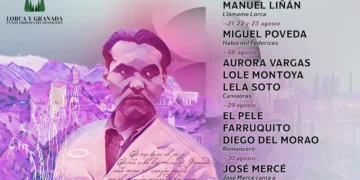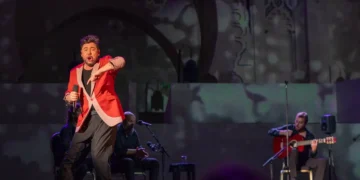|
29th FESTIVAL DE LA GUITARRA DE CÓRDOBA “FEDRA” |
|||||||||
|
Text: Rubén Gutiérrez THOSE WHO ARE ABOUT TO DIE SALUTE YOU Lola Greco (Freda), Amador Rojas (Hipólito), Alejandro Granados (Teseo), Carmelilla Montoya (Ama), Estefanía Ruiz (Aricia). Corps de ballet: Olga Aznar. Guerau Cabrera, Hugo López, Ricardo López, Verónica Llavero, José María Maldonado, Marta Nogal, Estefanía Ruiz. Cante: David Maldonado, Guitarra: Iván Losada, Percusión: Lucky Losada, Coreografía: Javir Latorre; Música: Enrique Morente; Dirección: Miguel Narros. Alter nearly twenty years, well-known director Miguel Narros returns to offer this new version of the myth of Phaedra. All that’s left of the original story from Euripides is the plot; the staging, wardrobe and symbolism have been completely updated. Phaedra, married to Teseo, falls in love with his stepson Hipólito, and everything is in place for the Greek tragedy. Enrique Morente’s music is fundamental as it guides us through the different acts. It’s strange that most of the compositions come pre-recorded, and then there are three singers, a guitarist and percussionist on stage. Despite the quality of David Maldonado, his voice is inaudible at times with all the Morente recordings and footwork. Carmelilla Montoya came off better, and was the absolute star. If there’s one thing this show has, it’s plenty of footwork, there’s no way to get through to the flamenco without the heel and toe, a much-overused trick to end the various compositions. Morente chose exclusively rhythmic cantes to illustrate the work, particularly the siguiriya, so well-suited to the tragic nature of the story. Also included is cante abandolao, bulerías por soleá, tientos, tangos and taranto. Let’s hope the soundtrack becomes available soon. Lola Greco, Alejandro Granados and Amador Rojas are constricted in their respective roles, acting out a script that depends more on mimicry and facial gestures than on flamenco dance as such. The corps de ballet is very good, and the choreographies are perfectly coordinated, with the added difficulty of dancing in ordinary street clothes, tight-fitting jeans and leather jackets. Kudos for the sirtaki included in the work, a wink to the Greek musical culture. The contemporary quality of the show is seen not only in the wardrobe, but in a motorbike Amador Rojas uses on stage, an element that leads to the tragic ending of his character. Lola Greco’s unrequited love throws her character into uncontrollable thoughts of death, and with the background of petenera, her suicide ends the show.
ALSO IN CÓRDOBA This year’s Córdoba festival had a greater flamenco presence than in recent editions. It shows in the large number of specialized courses, even Eva Yerbabuena was taken on as teacher. We were unable to attend Manolo Sanlúcar’s “Ocho Monumentos” and the recital of Cigala with Tomatito, although we saw the latter just a few days earlier in Roquetas de Mar (Almería). However we were fortunate enough to be able to enjoy two very worthwhile evenings at the Teatro de la Axerquía, with the added pleasure of fine weather instead of the intense heat that usually takes over in these parts in July. Enrique Morente, the King Midas of flamenco, not because he turns everything to gold, but rather into flamenco. He was announced along with Lagartija Nick to present “Omega”. Although the show has been reviewed at length in this electronic magazine, we want to point out a few things. First of all, Morente was very at ease, and began with “Alfa”, to arrive at “Omega”. He delivered a discreet flamenco recital of one hour, in which Chacón’s malagueña of the “convento”, and another of el Canario, were the outstanding moments. The guitar dynasty of the Habichuela family has a worthy heir in the person of young Juan Carmona Nieto. Estrella Morente appeared, and by then it had been nearly two and a half hours of recital when the family decided to pay their own personal tribute to the King of Pop. Tears welled up as Popo Gabarre did a convincing imitation of Michael Jackson’s dancing, and Estrella pulled out the black lady inside of her to sing Jackson-style. The news circulated quickly in Córdoba, and the following day Miguel Poveda was up to the challenge. His announced “Coplas del Querer” was presented as planned, leaving room for guitarist Chicuelo to play a bulerías solo. The Catalonian singer made much of his admiration for Joan Albert Amargós and violinist Olvido Lanza, with whom he closed out the concert. The recital, which lasted two hours, included a wide range of songs from Serrano, León, Quiroga y Perelló. But of course when it came time for encores, the audience begged for cante. Both on Morente’s night, and Poveda’s this excellent venue of the Axarquía was packecd to the rafters, and oddly enough, the average age of the audience was much lower for Morente than for Poveda. Miguel is becoming a true idol in the panorama of Spanish music, backed up by his National Prize for Music. He offered some excellent alegrías de Cádiz, ending with bulerías, and as one would expect, the audience wouldn’t let him go without a snippet of his “Alfileres de Colores”. The bottom line is, all the performers we saw in Córdoba were in great form and offered the best of themselves, like gladiators from the era of Seneca.
|
Descubre más desde Revista DeFlamenco.com
Suscríbete y recibe las últimas entradas en tu correo electrónico.

































